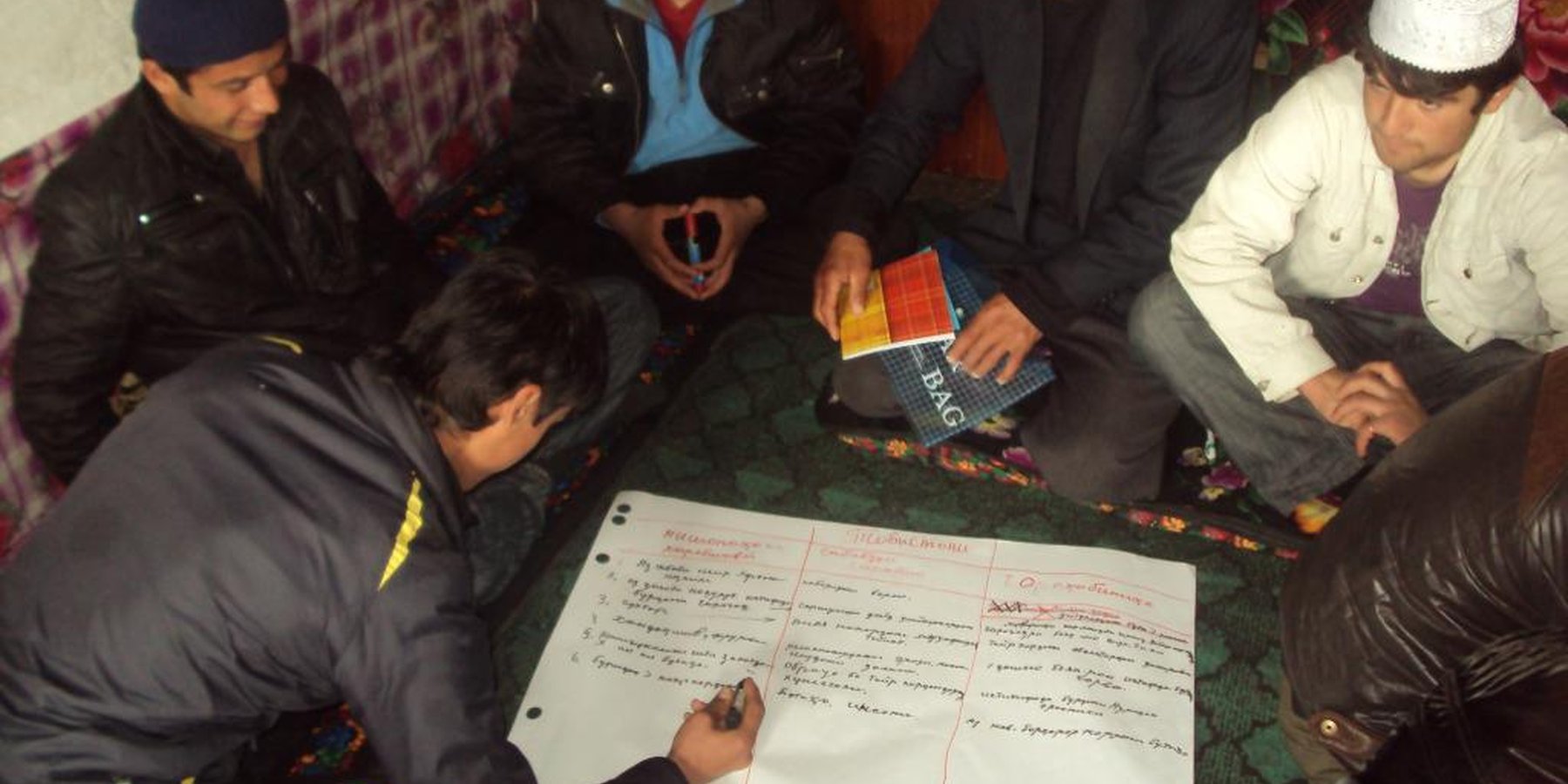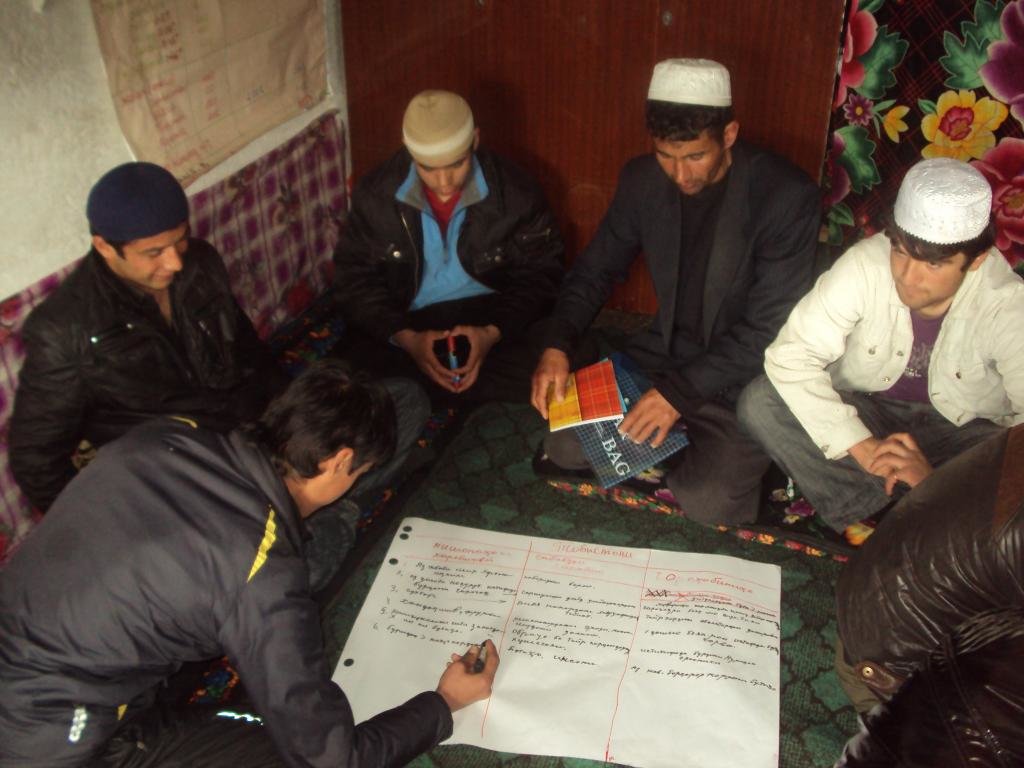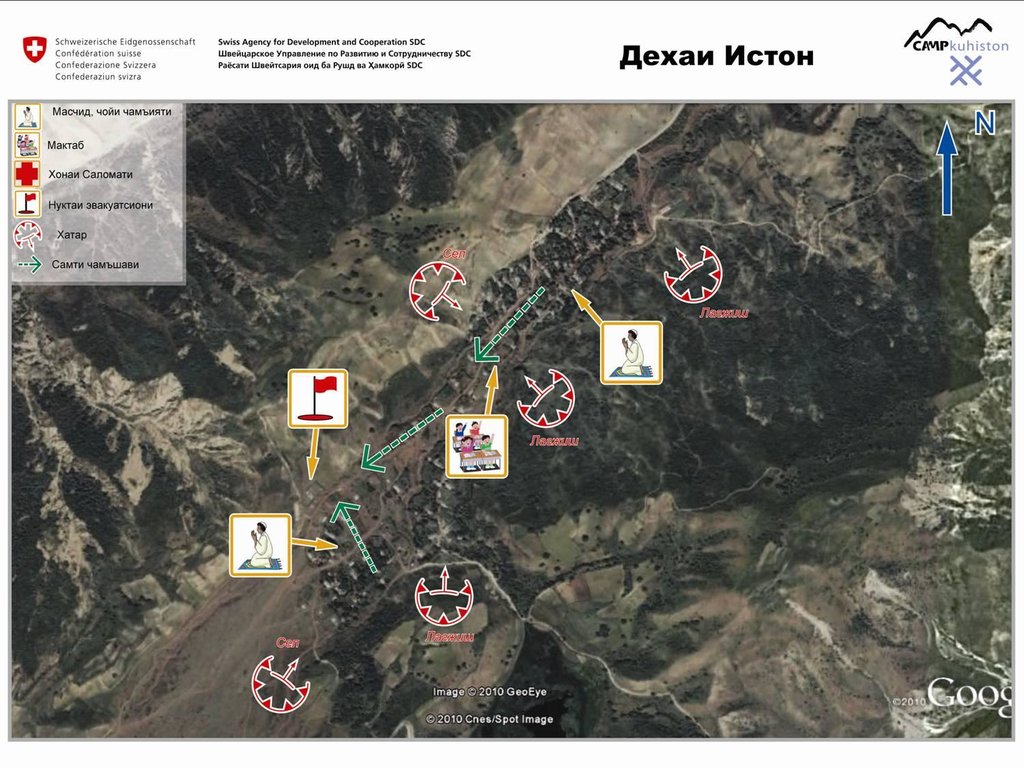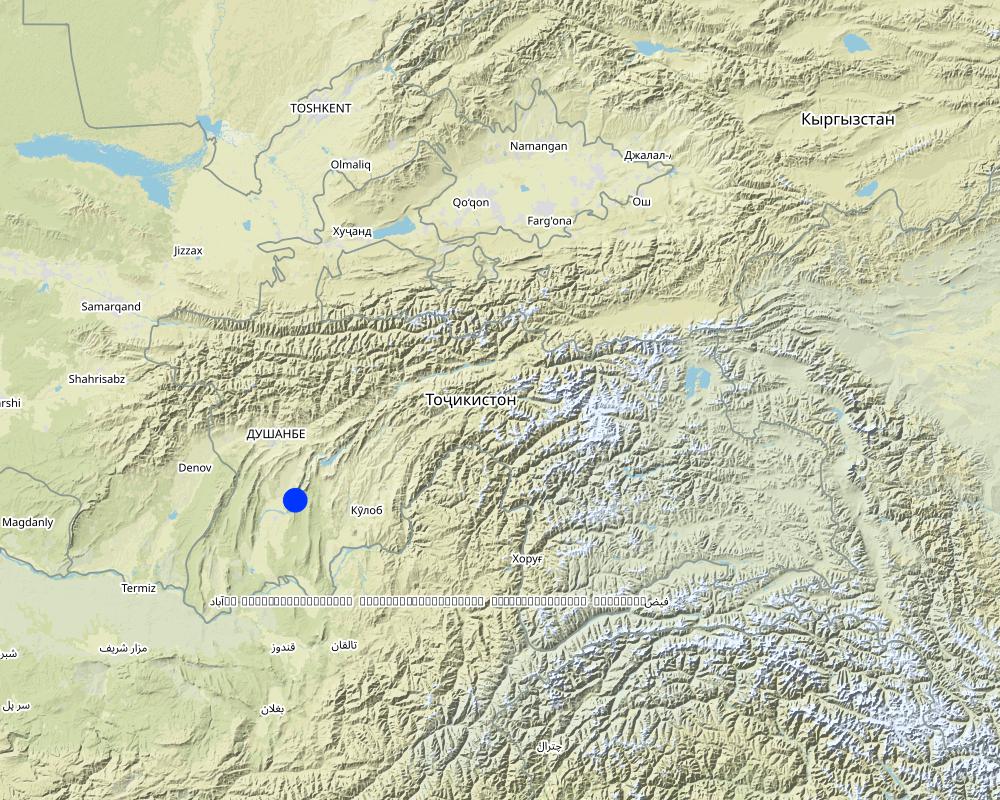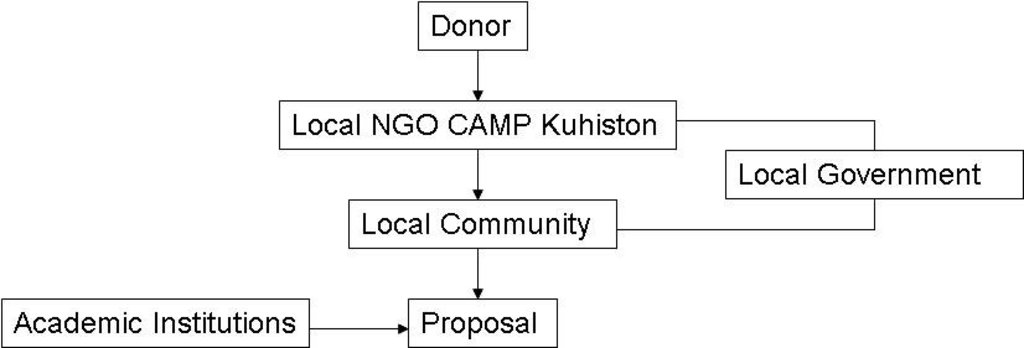Selection of SLM Technologies for Natural Disaster Risk Mitigation [Tayikistán]
- Creación:
- Actualización:
- Compilador: shane stevenson
- Editor: –
- Revisores: David Streiff, Alexandra Gavilano, Joana Eichenberger
CAMP Kuhiston
approaches_2437 - Tayikistán
Visualizar secciones
Expandir todo Colapsar todos1. Información general
1.2 Detalles de contacto de las personas de referencia e instituciones involucradas en la evaluación y la documentación del Enfoque
Especialista MST:
Especialista MST:
Pocheov Mirzokubon
+992 44 601 55 05
CAMP Kuhiston
Rudaki avenue, Dushanbe
Tayikistán
Nombre del proyecto que facilitó la documentación/ evaluación del Enfoque (si fuera relevante)
Pilot Program for Climate Resilience, Tajikistan (WB / PPCR)Nombre de la(s) institución(es) que facilitaron la documentación/ evaluación del Enfoque si fuera relevante)
CAMP - Central Asian Mountain Partnership (CAMP - Central Asian Mountain Partnership) - KirguistánNombre de la(s) institución(es) que facilitaron la documentación/ evaluación del Enfoque si fuera relevante)
CDE Centre for Development and Environment (CDE Centre for Development and Environment) - Suiza1.3 Condiciones referidas al uso de datos documentados mediante WOCAT
¿Cuándo se compilaron los datos (en el campo)?
10/06/2011
El compilador y la/s persona(s) de referencia claves aceptan las condiciones acerca del uso de los datos documentados mediante WOCAT :
Sí
1.4 Referencia/s al/los Cuestionario(s) de Tecnologías MST
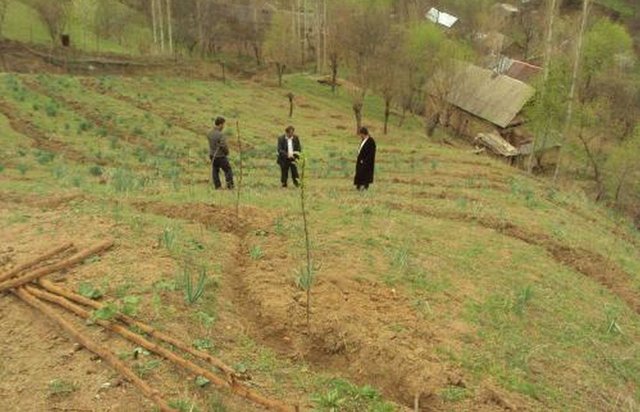
Planting of fruit trees to increase slope stabilisation [Tayikistán]
Planting fruit tree orchards to increase the stability of the steep loess soil slopes.
- Compilador: Gulniso Nekushoeva
2. Descripción del Enfoque MST
2.1 Breve descripción del Enfoque
Community Based Natural Disaster Risk Management Workshops for identification of locations for the implementation of SLM technology to reduce the risk to the village from natural disasters.
2.2 Descripción detallada del Enfoque MST
Descripción detallada del Enfoque MST:
Aims / objectives: The main objective was to use a community based participatory approach to evaluate the risk from natural hazards and aid in the effective selection of location and types of SLM Technologies that could be implemented. The workshop systematically works through the natural disaster risk assessment process which includes evaluation of the natural and human triggers that can causes and contribute to specific natural disasters and subsequently rank the risk as either high/medium/low based upon a predetermined criteria. The assessment is repeated with the assumption the SLM mitigation has been implemented to evaluate whether the natural disaster risk would be reduced.
Methods: Several methodologies are used in this approach, these include the, display of posters and photos, watching documentary style DVD’s, playing awareness raising training games, and distribution of brochures to educate the communities on the causes and impacts of natural disasters so that they can then complete a systematic risk assessment process. This is undertaken within the community using interactive participatory training modules and experienced teachers. Once the technologies are decided upon a proposal form is completed and copies submitted to funding agencies and the local government. A Memorandum of Understanding is signed with the local government to endorse the approach and any subsequent implementation activities. The proposal is vetted by experts for modification and approval to ensure best practice and sustainable results.
Stages of implementation: The communities are selected based upon natural disaster statistics and a natural disaster workshop conducted for up to twenty members of the community. At the completion of the workshop the community produce several proposals for the implementation of SLM technologies that will reduce the risk from specific natural disasters. The proposals are reviewed by experts from the soil institute and horticulture institute to ensure they are practical, viable and effective before final submission to the donor for funding. The local government remains informed of the activities throughout the process and is provided with copies of the proposals.
Role of stakeholders: NGO CAMP Kuhiston were the overall project managers. CAMP designed and conducted training on Disaster Risk Reduction and developed the natural hazard risk assessment process that leads to the formulation of the SLM mitigation proposals. CAMP are also responsible for engaging the experts and providing information to the local government who are asked to support the process. The community has to actively be involved and design their own proposal and decide how they will contribute to the implementation process.
Other important information: Although this could potentially be a lengthy process it is important that the communities understand why they have chosen a specific SLM technology and the desired impact that will help secure their livelihoods.
2.3 Fotos del Enfoque
2.5 País/ región/ lugares donde el Enfoque fue aplicado
País:
Tayikistán
Región/ Estado/ Provincia:
RRS
Especifique más el lugar :
Nurabad
Comentarios:
SLM was implemented in 7 different locations covering 5 villages within Mujiharf and Hakimi jamoats of Nurabad District. The two main watersheds are shown in the googleEarth file.
Map
×2.6 Fechas de inicio y conclusión del Enfoque
Indique año del inicio:
2009
Año de conclusión (si el Enfoque ya no se aplica):
2011
2.7 Tipo de Enfoque
- proyecto/ basado en un programa
2.8 Propósitos/ objetivos principales del Enfoque
The Approach focused mainly on SLM with other activities (Natural Disaster Risk Mitigation)
The main objective was to educate the communities on the causes and triggers of natural disasters and how these triggers can be combated by SLM technologies. The approach concentrated on making the link between SLM technologies and causes of natural disasters. The risk assessment process helped communities understand how to evaluate the risk to their community from different types natural disasters and how these proposals would help reduce the risk presented by these types of natural disasters and also where is was the most effective and efficient use of time, finance and resources to reduce this risk.
The SLM Approach addressed the following problems: The stabilisation of degraded slopes that increased the risk to communities from natural disaster such as mud flows, landslides, and avalanches.
2.9 Condiciones que facilitan o impiden la implementación de la/s Tecnología/s aplicadas bajo el Enfoque
normas y valores sociales/ culturales/ religiosos
- impiden
There were major problems incorporating women into the initial disaster risk management workshops and trainings. Therefore, there was limited input into the mitigation proposal development process.
Treatment through the SLM Approach: In some villages workshops were held separately from the men using female trainers. However, due to low educational backgrounds there was a limited the level of participation. The field training during the implementation stage managed to capture the women
disponibilidad/ acceso a recursos y servicios financieros
- impiden
There was initial concern that the farmers would not have finance to maintain the technology in the first year. The project was also conscious that fruit trees are subject to tax after three years.
Treatment through the SLM Approach: Farmers were provided with a minimal payment at different stages as the SLM technology developed.
entorno institucional
- impiden
The Jamoat wanted to have more say in the land owners who received the trees.
Treatment through the SLM Approach: The Jamoat were taken on site visits and were explained that the land was selected because of the hazard risk, not the land owner.
marco de trabajo legal (tenencia de tierra, derechos de uso de tierra y agua)
- impiden
There was no formal documentation to show who was the owner of the land.
Treatment through the SLM Approach: There was an informal agreement between the land user, village members and jamoat.
The existing land ownership, land use rights / water rights moderately hindered the approach implementation Although there are land use certificates available for farms, there are problems with allocating specific parcels of land to one particular land user. Therefore this issue needs to resolved before a technology can be implemented.
3. Participación y roles de las partes interesadas involucradas
3.1 Partes interesadas involucradas en el Enfoque y sus roles
- usuarios locales de tierras/ comunidades locales
Five local communities (20 people per community)
Individual land users were involved in workshops and planning of SLM Technology
Community were involved in workshops
Women particpitaed less, since there are noticeable gaps in the education levels of the genders and women fulfill a more traditional role centered around the household.
This area suffers from high levels of labour migration with many of the men working abroad in countries such as Russia. In particular separate workshops were held for women to ensure that they participated in the approach.
- especialistas MST/consejeros agrícolas
Specialists were involved in selection of location of implementation
- ONG
CAMP Kuhiston
CAMP Kuhiston developed the approach in collaboration with international support, land users, academic institutions, the local community and local government.
- gobierno local
Jamoats, Khukhmats
- gobierno nacional (planificadores, autoridades)
Tajik Soil Institute, Horticulture Institute,
- organización internacional
Voluntary Services Overseas, University of Bern
Si varias partes interesadas estuvieron involucradas, indique la agencia principal:
CAMP Kuhiston
3.2 Involucramiento de los usuarios locales de tierras/ comunidades locales en las distintas fases del Enfoque
| Involucramiento de los usuarios locales de tierras/ comunidades locales | Especifique quién se involucró y describa las actividades | |
|---|---|---|
| iniciación/ motivación | ninguno | |
| planificación | ninguno | |
| implementación | interactivo | Involved in the workshops and the development of the proposals |
| monitoreo y evaluación | ninguno | |
| Research | ninguno |
3.3 Flujograma (si estuviera disponible)
Descripción:
Organisation chart showing how the proposal for the SLM technology developed.
Autor:
S. Stevenson (CAMP Kuhiston)
3.4 La toma de decisiones en la selección de Tecnología(s) MST
Especifique quién decidió la selección de las Tecnología/ Tecnologías a implementarse:
- principalmente por especialistas MST en consulta con usuarios de tierras
Explique:
SLM specialists made the decision on the SLM technology, but consulted with the land users before implementation.
Decisions on the method of implementing the SLM Technology were made by NGO CAMP Kuhiston. NGO CAMP combined two funded projects to develop the approach for the implementation to the SLM technology with consultation from the Tajik Soil Institute and the Horticultural Institute.
4. Apoyo técnico, fortalecimiento institucional y gestión del conocimiento
4.1 Construcción de capacidades / capacitación
¿Se proporcionó la capacitación a usuarios de tierras/ otras partes interesadas?
Sí
Especifique quién fue capacitado:
- usuarios de tierras
- 20 members of five communities received training.
Si fuese relevante, también especifique género, edad, estatus, etnicidad, etc.
The training on the risk assessment process included all members of the community, although due to the conservative nature of the community some trainings were divided between women and men.
Forma de capacitación:
- en el contexto de trabajo
- cursos
Temas avanzados:
The initial training were on natural disasters, their casues and impacts. Subsequent training is the communites covered soil and water conservation and fruit cultivation.
4.2 Servicio de asesoría
¿Los usuarios de tierras tienen acceso a un servicio de asesoría?
No
4.3 Fortalecimiento institucional (desarrollo institucional)
¿Se establecieron o fortalecieron instituciones mediante el Enfoque?
- sí, un poco
Especifique el nivel o los niveles en los que se fortalecieron o establecieron las instituciones:
- local
Especifique el tipo de apoyo:
- construcción de capacidades/ entrenamiento
Proporcione detalles adicionales:
Two academic institutions were financially supported to undertake the review and evaluation process. Local NGO camp was supported by international finance to implement the approach and subsequent activities.
4.4 Monitoreo y evaluación
¿El monitoreo y la evaluación forman parte del Enfoque?
Sí
Comentarios:
no. of land users involved aspects were ad hoc monitored by project staff through observations; indicators: The level of involvement in the workshops by the land users.
socio-cultural aspects were ad hoc monitored by project staff through observations; indicators: The level of engagement of the government and of the women in the process.
management of Approach aspects were ad hoc monitored by project staff through observations; indicators: International staff provided informal monitoring of the approach.
technical aspects were ad hoc monitored by other through observations; indicators: The academic institutions reviewed the proposals.
There were few changes in the Approach as a result of monitoring and evaluation: The risk assessment process was simplified and the format of the proposals was made more understandable to the participants.
There were few changes in the Technology as a result of monitoring and evaluation: The monitoring of the SLM technology means that for replication of the technology there would be changes in tree species selected.
4.5 Investigación
¿La investigación formó parte del Enfoque?
Sí
5. Financiamiento y apoyo material externo
5.1 Presupuesto anual para el componente MST del Enfoque
Si no se conoce el presupuesto anual preciso, indique el rango:
- 10,000-100,000
Comentarios (ej. fuentes principales de financiamiento/ donantes principales):
Approach costs were met by the following donors: international non-government (International Consultants): 5.0%; international (Swiss Coorperation for Development and PAMS): 90.0%; local community / land user(s) (Local community support in kind): 5.0%
5.2 Apoyo financiero/material proporcionado a los usuarios de tierras
¿Los usuarios de tierras recibieron financiamiento/ apoyo material para implementar la Tecnología/ Tecnologías? :
No
5.3 Subsidios para insumos específicos (incluyendo mano de obra)
- construcción
| Especifique qué insumos se subsidiaron | En qué grado | Especifique los subsidios |
|---|---|---|
| parcialmente financiado | ||
| parcialmente financiado | ||
- otro
| Otro (especifique) | En qué grado | Especifique los subsidios |
|---|---|---|
| training materials | totalmente financiado | posters, stationery and teachers salary |
Si la mano de obra de usuarios de tierras fue un insumo sustancial, ¿fue:
- voluntario?
Comentarios:
The approach was financed by funds from a donor.
5.4 Crédito
¿Se proporcionó crédito bajo el Enfoque para actividades MST?
No
5.5 Otros incentivos o instrumentos
¿Se usaron otros incentivos o instrumentos para promover la implementación de Tecnologías MST?
Sí
Si fuera el caso, especifique :
Two academic institutions were financially supported to undertake the review and evaluation process. Local NGO camp was supported by international finance to implement the approach and subsequent activities.
6. Análisis de impacto y comentarios de conclusión
6.1 Impactos del Enfoque
¿El Enfoque ayudó a los usuarios de tierras a implementar y mantener Tecnologías MST?
- No
- Sí, un poco
- Sí, moderadamente
- Sí, mucho
The approach provided the land users with training, saplings and construction material to use the land in a more sustainable way.
¿El Enfoque empoderó a grupos en desventaja social y económica?
- No
- Sí, un poco
- Sí, moderadamente
- Sí, mucho
In some communities the women received specific training on the risk assessment process.
¿El Enfoque mejoró cuestiones de tenencia de tierra/ derechos de usuarios que obstaculizaron la implementación de la Tecnologías MST?
- No
- Sí, un poco
- Sí, moderadamente
- Sí, mucho
Where the technology was implemented, it made the community address the issue of land user rights. It is now apparent who is responsible for the SLM technology and for payment taxes on the land.
Did other land users / projects adopt the Approach?
- No
- Sí, un poco
- Sí, moderadamente
- Sí, mucho
Trainings were provided to other NGO's on the Natural Disaster Risk Assessment process and the development of proposals. The success of this has not been monitored.
Did the Approach lead to improved livelihoods / human well-being?
- No
- Sí, un poco
- Sí, moderadamente
- Sí, mucho
It improved their knowledge through training on Natural Disaster and on fruit cultivation and through the distribution of accompanying brochures.
Did the Approach help to alleviate poverty?
- No
- Sí, un poco
- Sí, moderadamente
- Sí, mucho
If the subsequently implemented technologies should help safeguard houses, land and livelihoods.
6.2 Motivación principal del usuario de la tierra para implementar MST
- producción incrementada
fruit crops within 3-5 years
- incremento de la renta(bilidad), proporción mejorada de costo-beneficio
land previously had limited economic output.
- prestigio, presión social/ cohesión social
Government decree to plant trees
- conciencia medioambiental
To decrease the communities exposure to natural disasters.
- well-being and livelihoods improvement
SLM technology should improve the livelihood of the land users.
6.3 Sostenibilidad de las actividades del Enfoque
¿Pueden los usuarios de tierras sostener lo que se implementó mediante el Enfoque (sin apoyo externo)?
- no
Si respondió no o incierto, especifique y comente:
The land users are not in a position to mobilise all the parties involved in the approach.
6.4 Fortalezas/ ventajas del Enfoque
| Fuerzas/ ventajas/ oportunidades desde la perspectiva del usuario de la tierra |
|---|
| The process allowed me to make decisions concerning my own village. |
| The training improved my understanding of human and environmental causes of natural disasters. |
| Fuerzas/ ventajas/ oportunidades desde la perspectiva del compilador o de otra persona de referencia clave |
|---|
| The approach involved a range of stakeholders and experts who were all able to actively contribute. (How to sustain/ enhance this strength: This could be enhanced by continued collaboration between all parties. ) |
| The approach included a community training element that benefited a broader range than just the land users. |
| The approach involved mobilisation of local government and community participation. (How to sustain/ enhance this strength: Further collaboration on technologies between the community and local government. The government to initiate replication in other communities. ) |
| The approach helped link the prevention of natural disaster with SLM practices. (How to sustain/ enhance this strength: The community developing further proposals for technologies and seeking funding to implement them.) |
6.5 Debilidades/ desventajas del Enfoque y formas de sobreponerse a ellos
| Debilidades/ desventajas/ riesgos desde la perspectiva del usuario de la tierra | ¿Cómo sobreponerse a ellas? |
|---|---|
| To provide more support on alternatives for SLM technologies. There must be new technologies that we are not aware of. | Further develop the modul to provide further illustrations of best practice. |
| Debilidades/ desventajas/ riesgos desde la perspectiva del compilador o de otra persona de referencia clave | ¿Cómo sobreponerse a ellas? |
|---|---|
| The approach covers only a one year period, therefore if the SLM technology has difficulties, such as disease which is highly prevalent in this area, the land owner may not be in a financial position to rectify the issue. | A longer monitoring and support period. |
7. Referencias y vínculos
7.1 Métodos/ fuentes de información
- visitas de campo, encuestas de campo
- entrevistas con usuarios de tierras
Vínculos y módulos
Expandir todo Colapsar todosVínculos

Planting of fruit trees to increase slope stabilisation [Tayikistán]
Planting fruit tree orchards to increase the stability of the steep loess soil slopes.
- Compilador: Gulniso Nekushoeva
Módulos
No se hallaron módulos


